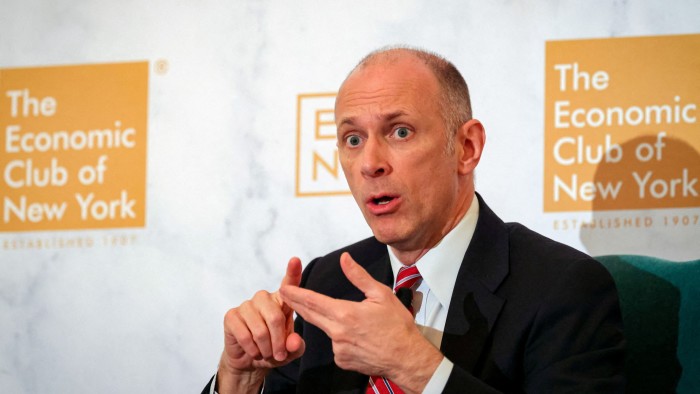Unlock the White House Watch newsletter for free
Your guide to what Trump’s second term means for Washington, business and the world
A top Federal Reserve official has warned rate-setters against “lurching” towards new cuts before inflation is fully under control, even as traders grow certain that the US central bank will lower borrowing costs in September.
Austan Goolsbee, president of the Chicago Fed and voter on the central bank’s interest rate-setting committee, struck a hawkish tone on Wednesday, telling journalists the Fed could face a “hard time” in pushing inflation back down to its 2 per cent target.
“The last thing that you want is to have the central bank lurching,” Goolsbee said on Wednesday. “I understand why it’s the business model of the market to process information as rapidly as it comes in. But that’s not in my conception of how the central bank should be operating.”
Markets began fully pricing in a 25 basis point cut earlier on Wednesday, amid mounting calls from President Donald Trump and officials in his administration to slash rates aggressively. Goolsbee’s intervention suggests central bank officials do not all agree.
A weak jobs report earlier this month and a relatively benign inflation report on Tuesday also prompted more bets that the Fed would start cutting rates.
The central bank has been hesitant to lower borrowing costs in recent months due to concerns that the US president’s trade war will push up prices. Trump officials say no evidence shows that his tariffs have sustainably added to inflation.
Scott Bessent, US Treasury secretary, said earlier on Wednesday that the central bank should consider lowering its benchmark target range of 4.25 per cent to 4.5 per cent by 50 basis points at its mid-September meeting.
But Goolsbee told journalists on Wednesday afternoon that the US jobs market remained stronger than it appeared in the recent labour market data for July.
He also said that some details in the inflation data had raised fears that the Fed’s efforts to stamp out price pressures were no longer on a “golden path”.
While Goolsbee said he “definitely” did not want to tie his hands “prematurely” and commit to keeping borrowing costs on hold, he suggested that the central bank should remain vigilant.
“If [high service price increases] persisted, we would have a hard time getting back to 2 per cent,” he said, referring to the Fed’s inflation target, as measured by Personal Consumption Expenditures.
Headline CPI inflation rose by 2.7 per cent in the year to July — on a par with June. But the core measure, which excludes changes in volatile food and energy prices and is considered a better measure of underlying price trends, increased from 2.9 per cent to 3.1 per cent.
The Chicago Fed chief added: “We had a couple of months of quite mild and favourable inflation readings, and now we’ve gotten, let’s call it one month, where there are some concerning elements.”
Goolsbee’s remarks put him at odds with Trump administration officials, who believe the price data released on Tuesday bolstered their claims that inflation is falling despite the president’s sweeping new taxes on imports.
“After this report, if I was a policymaker or an investor, I’d be thinking that this data unambiguously supports lower interest rates,” Joe Lavorgna, Bessent’s economic counsellor, told the Financial Times on Tuesday.
